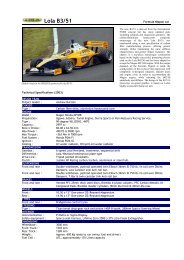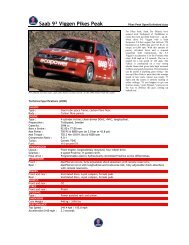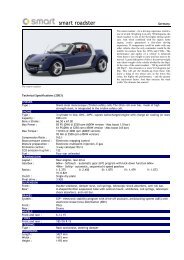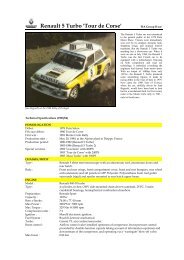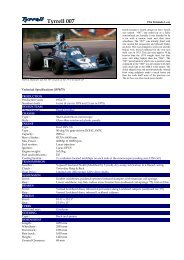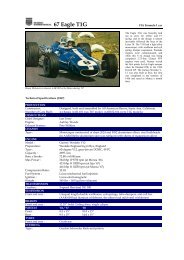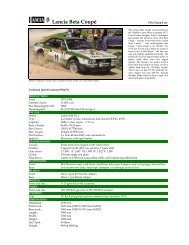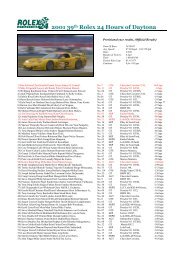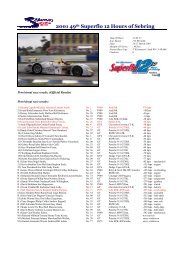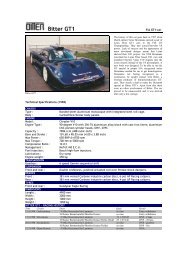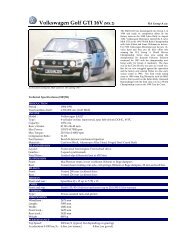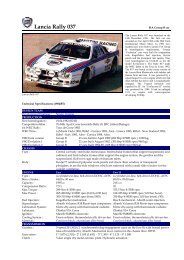70 Chaparral 2J - Motorsports Almanac
70 Chaparral 2J - Motorsports Almanac
70 Chaparral 2J - Motorsports Almanac
Create successful ePaper yourself
Turn your PDF publications into a flip-book with our unique Google optimized e-Paper software.
They managed neither a pole position (fastest qualifier) nor any wins. Their best finishes were a pair of seconds. Hall<br />
had planned on running his new, 2H in 1968, but development bugs kept it from debuting until 1969. He would be<br />
forced to race the 2G in 1968. The result was one pole but no wins. Las Vegas, the sixth and final race of the season, was<br />
also the last race as a driver for Jim Hall. Late in the race, his <strong>Chaparral</strong> collided with a backmarker, was launched into<br />
the air, and landed upside down. Hall was rescued from the ensuing fire, but his severely broken legs lead to his<br />
retirement from driving. Although introduced by Jim Hall in 1966, not many cars besides the <strong>Chaparral</strong>s used high<br />
wings for extra downforce. Several cars carried them in 1969, but Hall himself introduced another radical car, the<br />
previously mentioned <strong>Chaparral</strong> 2H. Dubbed "The Great White Whale", because it looked like one, it would not be one<br />
of Hall's better efforts. It was originally designed as a narrow coupe with windows in the doors because the driver sat so<br />
low in the body. Driver John Surtees felt that visibility was poor and had Hall take the car's canopy off and raise the<br />
driver's seat. The vestigial passenger seat remained under the bodywork. There was a low wing at the back of the body.<br />
This <strong>Chaparral</strong> didn't cut it. The team bought a McLaren M12 to use while they continued to sort the 2H out. At one<br />
point in the season, the 2H wore a huge wing in the center of the car with the struts mounted to the sides of the car.<br />
Quite possibly, the most bizarre looking racer ever built. Although Hall and Surtees never got along well, Hall took full<br />
responsibility for the failure. He felt that had he not broken his legs, which kept him from test driving, he could have<br />
sorted the car out. At any rate, the team's direction changed for 19<strong>70</strong>. The FIA, auto racing's world ruling body,<br />
outlawed tall wings (from now on they would have to be near the bodywork) after 1969 because of some spectacular<br />
accidents that had occurred to F1 racers. Also, "movable" aerodynamic devices such as <strong>Chaparral</strong>'s flipper wings were<br />
outlawed. Jim Hall's answer to this, the <strong>Chaparral</strong> <strong>2J</strong>, did not debut until the third race of the 19<strong>70</strong> Can-Am season in<br />
July at Watkins Glen, New York. The <strong>2J</strong> was as radical as the 2E and 2H had been. Maybe more so. The car looked like a<br />
white brick. A very fast white brick. The car carried two motors. A 465 cubic inch Chevy V8 powered the rear wheels<br />
and a 274 cc Rockwell snowmobile engine powered a pair of "sucker" fans in the rear bodywork. The fans sucked air out<br />
from under the car, creating a vacuum that held the <strong>2J</strong> on the track. Sliding Lexan skirts were placed around the bottom<br />
edge of the body to seal the "plenum" area under the car. Enough suction could be generated to hold the car upside<br />
down on the ceiling of a room! Where a wing generates downforce (good) it also generates drag (bad). The suction<br />
device generated downforce with no drag loss. Reigning F1 World Driving Champion Jackie Stewart qualified the <strong>2J</strong><br />
third at Watkins Glen and drove the race's fastest lap, but his race was cut short by brake problems. The <strong>Chaparral</strong> team<br />
missed the next three races but returned to competition in September at Road Atlanta. They also brought a new driver<br />
with them, Vic Elford. Elford drove the <strong>2J</strong> in three of the remaining four races. (The team would miss one more race.)<br />
Elford was fastest qualifier in all three of those races but he only finished one (sixth at Road Atlanta). Something always<br />
broke. But the competition felt that, with a year of experience under their belt, the <strong>Chaparral</strong> team would bury them in<br />
1971. Competitors were always lobbying the SCCA to ban the <strong>2J</strong>. At the end of the season it was. The sliding Lexan<br />
skirts were said to have violated the "moveable aerodynamic device" ban. With that, Jim Hall closed up shop. An era in<br />
international autoracing had come to a close. Hall did return to autoracing in 1980 with the <strong>Chaparral</strong> 2K Indycar.<br />
Johnny Rutherford won the Indy 500 that year in the car. Hall owned a CART Indycar team into the 1990s, but bought<br />
his team's chassis from other companies.<br />
HALL’S CHAPARRALS<br />
In 1961, race car builders Tom Barnes and Dick Troutman approached Texas-born race driver Jim Hall about a sports<br />
racer they had designed. Although initially called the "Riverside," that was the beginning of the <strong>Chaparral</strong> legacy. The<br />
<strong>Chaparral</strong> 1 was a Chevy-powered, front-engined car that had a common heritage with the Scarab rear-engined racer<br />
that was previously designed by Barnes and Troutman. Its first race was at a Sports Car Club of America (SCCA) race at<br />
Laguna Seca, California in June 1961. Jim Hall brought his new <strong>Chaparral</strong> 1 to a 2nd place finish. Hall raced the<br />
<strong>Chaparral</strong> three more times in 1961, with a 3rd place at the October Riverside L.A. Time Grand Prix and DNFs at<br />
another Laguna Seca race and at the Nassau Speed Week main event. Jim Hall drove the <strong>Chaparral</strong> 1 to victories at the<br />
Road America Sprints in June 1962 and the Road America 500 in September 1962. The next incarnation of the <strong>Chaparral</strong><br />
was originally intended to be a coupe-bodied sports racer patterned after Chevrolet's Corvair Monza GT concept car of<br />
1962. The eventual open cockpit <strong>Chaparral</strong> 2A, however, maintained the pointed nose and other design elements of the<br />
Monza GT. The <strong>Chaparral</strong>'s first race, at the 1963 Riverside L.A. Times Grand Prix, ended in a DNF for Jim Hall. but this<br />
was to be the beginning of one of the most successful, if short-lived, runs in American unlimited sports car history.<br />
Running in the U.S. Road Racing Championship and a series of Pacific fall races (which included races at Riverside and<br />
Laguna Seca), Jim Hall and Hap Sharp took their <strong>Chaparral</strong> 2s to an incredible 7 1sts and 7 2nds in 16 races in 1964, and<br />
16 1sts and 9 2nds in 21 races in 1965! Among the 1965 victories was the 12 Hours of Sebring, a race that saw Jim Hall's<br />
open cockpit racer beat Carroll Shelby's coupe-bodied Cobras and GT-40s, although the skies open to flood the race<br />
track during the early evening hours. Jim Hall was known for innovation, and that innovation started to show itself in<br />
the <strong>Chaparral</strong> 2C, an upgraded version of the <strong>Chaparral</strong> 2A that included a hydraulic rear spoiler that the driver could<br />
raise in the turns and lower for less drag in the straightaways. The next evolution of Hall's racer, the <strong>Chaparral</strong> 2E made<br />
it's debut at the Can-Am race at Bridgehampton, New York in September 1966. This unique racer had a huge, highmounted<br />
wing that, like the 2C's spoiler, was hydraulically operated to shift its angle depending on the track conditions.<br />
The <strong>Chaparral</strong> 2E and a later development versionn called the 2G had short racing careers, competing in 17 Can-Am<br />
races during 1966 through 1969. Although the car was unbeatable, it had reliability problems that resulted in many<br />
DNFs. The <strong>Chaparral</strong> 2Es and 2Gs actually only scored 2 Can-Am victories and 6 2nd place finishes. Jim Hall's driving<br />
career came to an unfortunate and almost fatal end in November 1967, when his <strong>Chaparral</strong> 2G struck the back of Lothar<br />
Motschenbacher's McLaren and was catapulted into the air. The car landed on its tail and flipped over on its back,<br />
resulting in Hall suffering two badly broken legs and a dislocated jaw. Despite the end of his driving career, Jim Hall



